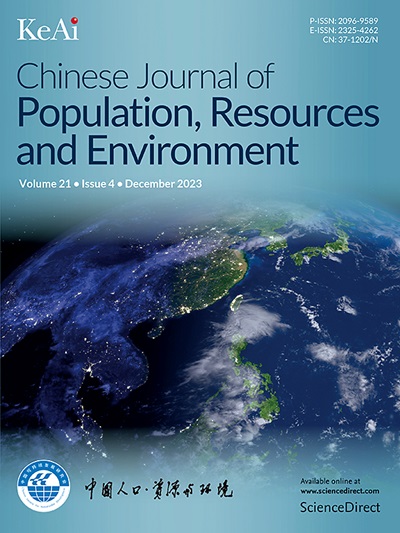中国工业二氧化硫排放与经济增长的脱钩:一个两阶段分解方法
IF 4.8
4区 环境科学与生态学
Q2 ENVIRONMENTAL STUDIES
Chinese Journal of Population Resources and Environment
Pub Date : 2025-03-01
DOI:10.1016/j.cjpre.2025.01.005
引用次数: 0
摘要
探索中国二氧化硫(SO2)排放与经济增长(DEI)脱钩的驱动因素对于实现可持续发展至关重要。通过分析SO2产生阶段和处理阶段的解耦指标和驱动因素,可以制定更有效的有针对性的缓解策略。我们采用Tapio解耦模型,并提出一种两阶段方法来检查与二氧化硫相关的解耦问题。研究结果表明:①DEI呈现出稳定而显著的改善趋势,其中SO2排放强度是主要驱动因素;②对于经济增长与二氧化硫产生的脱钩,能源规模是最大的刺激因子,而能源强度的影响由负向正变化,污染强度先正后负。③对于SO2生成与去除率的解耦,处理效率是最大的促进因素,其次是处理强度。基于这些结果,本研究建议中国更多地关注提高清洁能源的利用和处理过程的有效性。本文章由计算机程序翻译,如有差异,请以英文原文为准。
Decoupling economic growth from industrial SO2 emissions in China: A two-stage decomposition approach
Exploring the factors driving the decoupling of China’s sulfur dioxide (SO2) emissions from economic growth (DEI) is crucial for achieving sustainable development. By analyzing the decoupling indicators and driving factors at both the generation and treatment stages of SO2, more effective targeted mitigation strategies can be developed. We employ the Tapio decoupling model and propose a two-stage method to examine the decoupling issues related to SO2. Our findings indicate that: ① DEI shows a steady and significant improvement, with SO2 emission intensity identified as the primary driver. ② for the decoupling of economic growth and SO2 generation, energy scale serves as the largest stimulator, while the effect of energy intensity changes from negative to positive, and pollution intensity is first positive and then negative. ③ For the decoupling of SO2 generation and SO2 removal, treatment efficiency leads as the largest promoter, followed by treatment intensity. Based on these results, this study recommends that China focuses more on enhancing clean energy utilization and the effectiveness of treatment processes.
求助全文
通过发布文献求助,成功后即可免费获取论文全文。
去求助
来源期刊

Chinese Journal of Population Resources and Environment
ENVIRONMENTAL STUDIES-
CiteScore
4.30
自引率
1.10%
发文量
791
审稿时长
79 days
期刊介绍:
The Chinese Journal of Population, Resources and Environment (CJPRE) is a peer-reviewed international academic journal that publishes original research in the fields of economic, population, resource, and environment studies as they relate to sustainable development. The journal aims to address and evaluate theoretical frameworks, capability building initiatives, strategic goals, ethical values, empirical research, methodologies, and techniques in the field. CJPRE began publication in 1992 and is sponsored by the Chinese Society for Sustainable Development (CSSD), the Research Center for Sustainable Development of Shandong Province, the Administrative Center for China's Agenda 21 (ACCA21), and Shandong Normal University. The Chinese title of the journal was inscribed by the former Chinese leader, Mr. Deng Xiaoping. Initially focused on China's advances in sustainable development, CJPRE now also highlights global developments from both developed and developing countries.
 求助内容:
求助内容: 应助结果提醒方式:
应助结果提醒方式:


